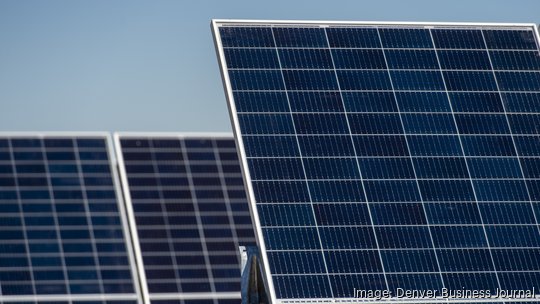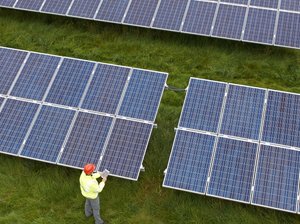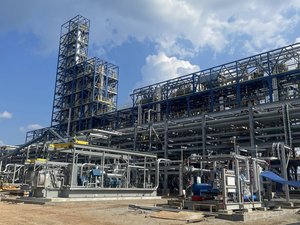
Two solar and battery storage projects in rural areas of Wisconsin — one on the reservation of the Bad River Band of Lake Superior Chippewa and another spanning land of the Red Cliff Band of Lake Superior Chippewa and Bayfield County — could receive nearly $24 million in federal dollars to cover a big portion of development costs, the U.S. Department of Energy and Wisconsin Gov. Tony Evers has announced.
The selections are part of the Department of Energy's (DOE) Energy Improvements in Rural or Remote Areas program, which is managed by the DOE Office of Clean Energy Demonstrations, or OCED. While the DOE selected the two Wisconsin projects for award negotiations, the Department hasn't yet distributed any money to the projects, which are two of the 17 total community energy projects chosen for award negotiations across the country.
The projects aim to deploy minigrid technology to build energy resilience in communities that often face extreme weather events and power outages along the shores of Lake Superior.
In one project, the Bad River Band of Lake Superior Chippewa (also known as Mashkiiziibii in the Ojibwemowin language) will serve as the project’s lead contractor to build a planned 5 megawatts of solar power plus 8 megawatt-hours of battery storage in facilities connected with existing diesel and natural gas generation to form a hybrid minigrid.
The system would enable the reservation’s Odanah and Birch Hill communities to maintain power amid power outages and help the Bad River Band reach its goal of net zero carbon emissions with 100% renewable electricity generation by 2027 and provide a model for replication in other tribes and rural communities. The DOE is pledging $14.08 million for its share of the cost.
The tribe anticipates the project will also provide jobs and financial benefits to tribal members, who face a 14% unemployment rate. The project aims to contribute $200,000 to workforce development training for local tribal members and contract 50% of workers from the tribal community, according to the DOE.
The other project covers land across Bayfield County and the Red Cliff Reservation. The effort is led by Evers' Office of Sustainability and Clean Energy, in collaboration with the Wisconsin Economic Development Corp.'s Office of Rural Prosperity, the Red Cliff Band of Lake Superior Chippewa and Bayfield County.
The program will work with utility and renewable partners to install microgrids throughout Bayfield County and on tribal lands, aiming to deploy solar power, battery storage and smart controls to enable islanding and electric vehicle charging stations.
The deployment of 23 microgrid systems in remote towns along Lake Superior is targeted to help residents who face frequent power outages due to lake-enhanced extreme weather events. The DOE's expected share of the cost is $9.78 million.
Federal dollars might not flow to the projects for another several months, Regina Galer, program manager for the DOE's Energy Improvements in Rural or Remote Areas program, told Albuquerque Business First in response to questions about two similar projects in New Mexico. Galer said the DOE will begin negotiations with the 17 selectees over the next few weeks, and she said the negotiation process could take "a couple months."
The negotiation process includes formalizing project details — which include budget, permitting and development time frame — and signing cooperative agreements between project developers and the DOE, she said.
Galer said the rural-focused program's goal is improving energy reliability in areas with fewer than 10,000 people.
A majority — 12 of the 17 selected projects — are tribal or have tribal beneficiaries, although Galer said the program is not explicitly tribal-focused. Other selected projects include a more than $25 million project to boost Alaskan tribal energy sovereignty, a Navajo Nation and Hopi Tribe project that aims to electrify 300 tribal homes across the regions through installing 2.5 kilowatts worth of off-grid solar and battery storage systems, and an over $9 million community solar project on Hopi Tribal land in Arizona.
"There are just so many excellent proposals from Indian Country," Galer said. "In a way it's not surprising, because there's such need. There's such high energy burden in tribal communities, and recognizing that people are really rising to the occasion. There were great technical merit and great community benefits merit in those applications."
While the federal funding may be managed by the DOE Office of Clean Energy Demonstrations, Galer said proving out new technologies isn't the program's focus. Rather, she said the program will look to demonstrate specific business models that could be copied across other rural areas to accelerate clean energy development.
Investors, renewable energy companies, utilities and other community stakeholders can watch how the 17 selected projects develop to inform their own future project development.
"We hope that by defraying some of the cost of investment, that we are setting up models that others will follow," Galer said.
She added OCED has about half of its money left to deploy as part of the Energy Improvements in Rural or Remote Areas program and could release a second solicitation for rural energy projects, although she didn't provide any time frame for when that second solicitation could come. Other funding opportunities under the OCED's Energy Improvements in Rural or Remote Areas program include the Energizing Rural Communities Prize and the ERA Fixed Grant Award Program.
Money for the Energy Improvements in Rural or Remote Areas program comes from the Bipartisan Infrastructure Law. The DOE intends to award more than $366 million for the 17 total projects.







